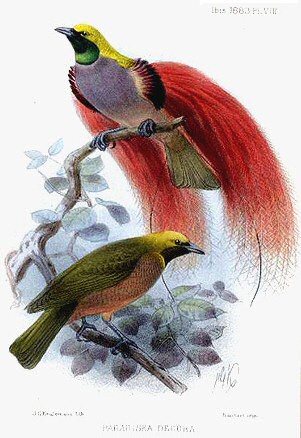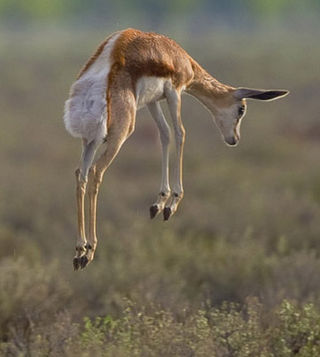
Sexual selection is a mechanism of evolution in which members of one biological sex choose mates of the other sex to mate with, and compete with members of the same sex for access to members of the opposite sex. These two forms of selection mean that some individuals have greater reproductive success than others within a population, for example because they are more attractive or prefer more attractive partners to produce offspring. Successful males benefit from frequent mating and monopolizing access to one or more fertile females. Females can maximise the return on the energy they invest in reproduction by selecting and mating with the best males.

Peafowl is a common name for two bird species of the genus Pavo and one species of the closely related genus Afropavo within the tribe Pavonini of the family Phasianidae. Male peafowl are referred to as peacocks, and female peafowl are referred to as peahens.

A lek is an aggregation of male animals gathered to engage in competitive displays and courtship rituals, known as lekking, to entice visiting females which are surveying prospective partners with which to mate. It can also refer to a space used by displaying males to defend their own share of territory for the breeding season. A lekking species is characterised by male displays, strong female mate choice, and the conferring of indirect benefits to males and reduced costs to females. Although most prevalent among birds such as black grouse, lekking is also found in a wide range of vertebrates including some bony fish, amphibians, reptiles, mammals, and arthropods including crustaceans and insects.

The handicap principle is a disputed hypothesis proposed by the Israeli biologist Amotz Zahavi in 1975. It is meant to explain how "signal selection" during mate choice may lead to "honest" or reliable signalling between male and female animals which have an obvious motivation to bluff or deceive each other. The handicap principle suggests that secondary sexual characteristics are costly signals which must be reliable, as they cost the signaller resources that individuals with less of a particular trait could not afford. The handicap principle further proposes that animals of greater biological fitness signal this through handicapping behaviour, or morphology that effectively lowers overall fitness. The central idea is that sexually selected traits function like conspicuous consumption, signalling the ability to afford to squander a resource. Receivers then know that the signal indicates quality, because inferior-quality signallers are unable to produce such wastefully extravagant signals.

Fisherian runaway or runaway selection is a sexual selection mechanism proposed by the mathematical biologist Ronald Fisher in the early 20th century, to account for the evolution of ostentatious male ornamentation by persistent, directional female choice. An example is the colourful and elaborate peacock plumage compared to the relatively subdued peahen plumage; the costly ornaments, notably the bird's extremely long tail, appear to be incompatible with natural selection. Fisherian runaway can be postulated to include sexually dimorphic phenotypic traits such as behavior expressed by a particular sex.

The Journal of Theoretical Biology is a biweekly peer-reviewed scientific journal covering theoretical biology, as well as mathematical, computational, and statistical aspects of biology. Some research areas covered by the journal include cell biology, evolutionary biology, population genetics, morphogenesis, and immunology.
Evolutionary game theory (EGT) is the application of game theory to evolving populations in biology. It defines a framework of contests, strategies, and analytics into which Darwinian competition can be modelled. It originated in 1973 with John Maynard Smith and George R. Price's formalisation of contests, analysed as strategies, and the mathematical criteria that can be used to predict the results of competing strategies.

Within evolutionary biology, signalling theory is a body of theoretical work examining communication between individuals, both within species and across species. The central question is when organisms with conflicting interests, such as in sexual selection, should be expected to provide honest signals rather than cheating. Mathematical models describe how signalling can contribute to an evolutionarily stable strategy.

In biology, altruism refers to behaviour by an individual that increases the fitness of another individual while decreasing their own. Altruism in this sense is different from the philosophical concept of altruism, in which an action would only be called "altruistic" if it was done with the conscious intention of helping another. In the behavioural sense, there is no such requirement. As such, it is not evaluated in moral terms—it is the consequences of an action for reproductive fitness that determine whether the action is considered altruistic, not the intentions, if any, with which the action is performed.
In evolution, cooperation is the process where groups of organisms work or act together for common or mutual benefits. It is commonly defined as any adaptation that has evolved, at least in part, to increase the reproductive success of the actor's social partners. For example, territorial choruses by male lions discourage intruders and are likely to benefit all contributors.

Avishag Kadman-Zahavi was an Israeli professor emeritus of Plant Physiology at The Volcani Center for Agricultural Research, Bet-Dagan, Israel. She is best known for her close collaboration with her husband Amotz Zahavi, who developed together with her the so-called Handicap principle, a sociobiological approach to the theory of natural selection.

The lek paradox is a conundrum in evolutionary biology that addresses the persistence of genetic variation in male traits within lek mating systems, despite strong sexual selection through female choice. This paradox arises from the expectation that consistent female preference for particular male traits should erode genetic diversity, theoretically leading to a loss of the benefits of choice. The lek paradox challenges our understanding of how genetic variation is maintained in populations subject to intense sexual selection, particularly in species where males provide only genes to their offspring. Several hypotheses have been proposed to resolve this paradox, including the handicap principle, condition-dependent trait expression, and parasite resistance models.

The Arabian babbler is a passerine bird until recently placed in the genus Turdoides. It is a communally nesting resident bird of arid scrub in the Middle East which lives together in relatively stable groups with strict orders of rank.
Alan Grafen is a Scottish ethologist and evolutionary biologist. He currently teaches and undertakes research at St John's College, Oxford. Along with regular contributions to scientific journals, Grafen is known publicly for his work as co-editor of the 2006 festschrift Richard Dawkins: How a Scientist Changed the Way We Think, honouring the achievements of his colleague and former academic advisor. He has worked extensively in the field of biological game theory, and, in 1990, devised a model showing that Zahavi's well-known handicap principle could theoretically exist in natural populations.
Competitive altruism is a possible mechanism for the persistence of cooperative behaviors, specifically those that are performed unconditionally. The theory of reciprocal altruism can be used to explain behaviors that are performed by a donor who receives some sort of benefit in the future. When no such compensation is received, however, reciprocity fails to explain altruistic behavior.

In biology and game theory, the Sir Philip Sidney game is used as a model for the evolution and maintenance of informative communication between relatives. Developed by John Maynard Smith as a model for chick begging behavior, it has been studied extensively including the development of many modified versions.

Eran Zahavi is an Israeli professional footballer who plays as a forward for and vice-captains both Israeli Premier League club Maccabi Tel Aviv and the Israel national team.
A biological ornament is a characteristic of an animal that appears to serve a decorative function rather than a utilitarian function. Many are secondary sexual characteristics, and others appear on young birds during the period when they are dependent on being fed by their parents. Ornaments are used in displays to attract mates, which may lead to the evolutionary process known as sexual selection. An animal may shake, lengthen, or spread out its ornament in order to get the attention of the opposite sex, which will in turn choose the most attractive one with which to mate. Ornaments are most often observed in males, and choosing an extravagantly ornamented male benefits females as the genes that produce the ornament will be passed on to her offspring, increasing their own reproductive fitness. As Ronald Fisher noted, the male offspring will inherit the ornament while the female offspring will inherit the preference for said ornament, which can lead to a positive feedback loop known as a Fisherian runaway. These structures serve as cues to animal sexual behaviour, that is, they are sensory signals that affect mating responses. Therefore, ornamental traits are often selected by mate choice.

Parasite-stress theory, or pathogen-stress theory, is a theory of human evolution proposing that parasites and diseases encountered by a species shape the development of species' values and qualities, proposed by researchers Corey Fincher and Randy Thornhill.

Allofeeding is a type of food sharing behaviour observed in cooperatively breeding species of birds. Allofeeding refers to a parent, sibling or unrelated adult bird feeding altricial hatchlings, which are dependent on parental care for their survival. Allofeeding also refers to food sharing between adults of the same species. Allofeeding can occur between mates during mating rituals, courtship, egg laying or incubation, between peers of the same species, or as a form of parental care.














